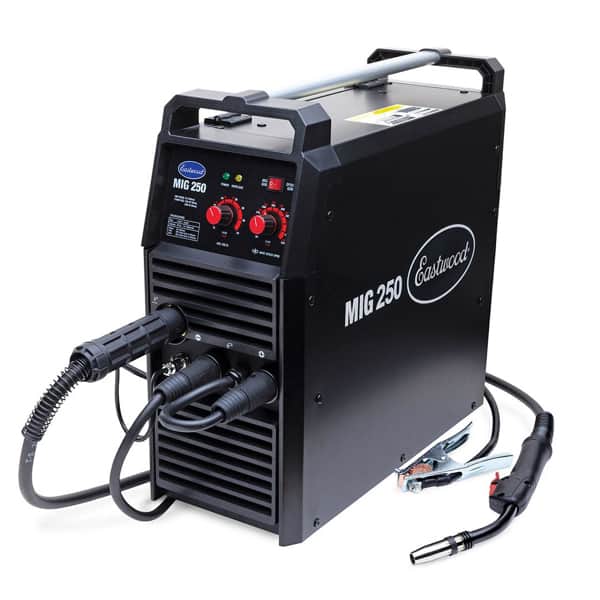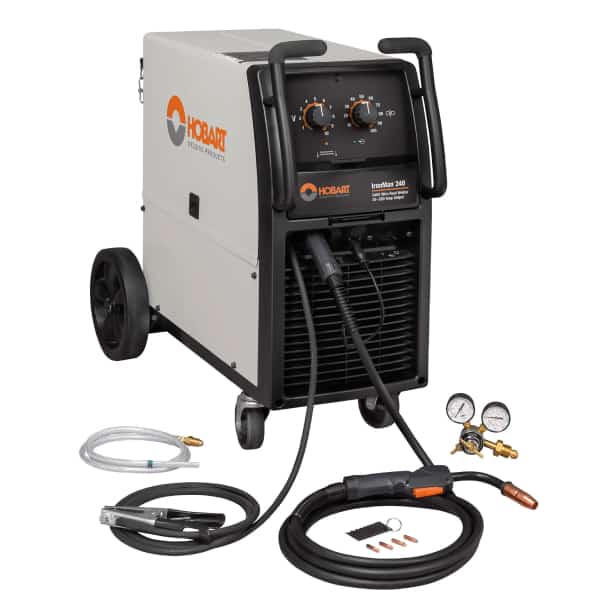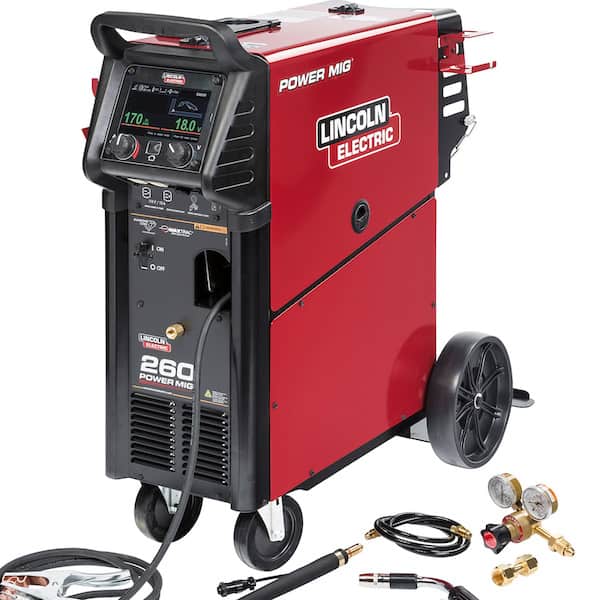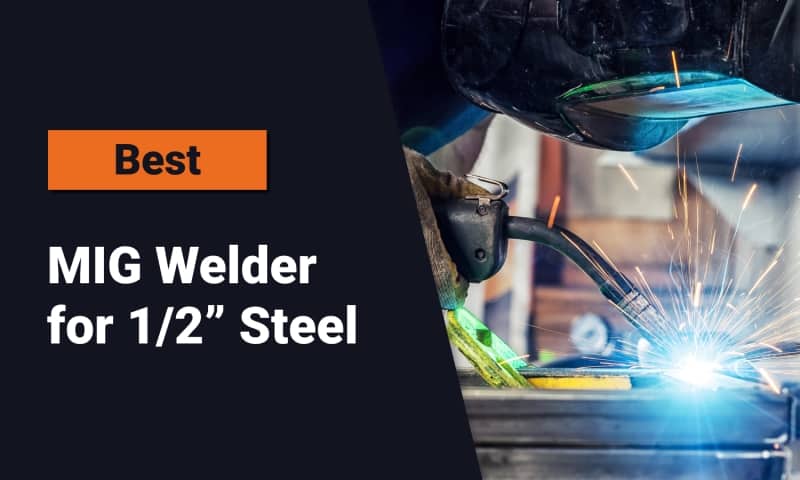Welding 1/2 in. thick mild steel in a single pass requires an output of at least 250 amps for consistent, proper joint penetration.
Numerous welders on the market satisfy this “power” specification, but only a few are worth your consideration.
In this article, you’ll learn which MIG welder is best for 1/2 in. steel, depending on your needs. Additionally, we’ll discuss essential MIG welder functions and features you should look for in our buying guide for rookies.
A Quick Comparison
| Product | |||
|---|---|---|---|
| Image | Product | Details | |

|
Eastwood 250 Amp MIG Welder |
Affordable yet well built Dual voltage input Lightweight and portable |
|

|
Hobart IronMan 240 MIG Welder |
Transformer-based Excellent arc quality Made in the USA |
|

|
Lincoln Electric Power MIG 260 |
7 in. display Advanced features Transformer-based |
|

|
Everlast PowerMIG 275P |
Unique Pulse MIG approach Portable Feature-rich |
|

|
Millermatic 252 MIG Welder |
10-Years old Transformer-based Highest arc and build quality |
Top 5 MIG Welders for 1/2 in. Thick Steel
We compiled the best welders below to satisfy different buyer needs. For example, a DIY weekend warrior doesn’t need to spend thousands of dollars on heavy-duty, professional-grade equipment.
1. Eastwood 250 Amp MIG Welder

- 120/240V input
- 60% duty cycle at 250A output
- Weighs a mere 46 lbs
- Spool gun support
- IGBT Inverter technology
- Quick feed for simple manual wire feeding
- 3-year warranty
Pros
- Most affordable, high-quality 250A MIG welder
- Stable, crisp arc
- Latest inverter technology
- Infinitely adjustable settings
- Sound amperage output at 120V
- Includes high-quality Trafimet MIG torch
- USA Brand with a good reputation
- Cast aluminum wire drive
- Supports 0.045 in. wire
- Breaker-style on/off switch
- Includes recommended settings chart
Cons
- No digital display
- The aluminum drive is lower quality compared to other welders in our review
- Short leads
- It doesn’t support any helpful features like 2T/4T
- No support for wire spools larger than 10 in. diameter
Overview
The Eastwood MIG 250A is the best budget welder for 1/2 in thick steel. Configured for light fabrication and DIY hobbyists, the design does lack some high-end features. The streamlined functions limit it in a professional environment, but Eastwood built this welder to sustain daily heavy-duty use.
If you run a welding shop, it can certainly handle the load. But it misses crucial features like pulse MIG, push-pull gun support for advanced aluminum welding, 2T/4T, etc. Hobbyists don’t need most of these features, so the low price, excellent build, and arc quality make this Eastwood model a bargain.
The welder is as simple to operate as Hobart’s Ironman 240 and includes everything. However, the Eastwood 250A’s leads are shorter than competing models. The 3-year warranty rivals high-end brands, but the build quality falls short of the high-end brands. For example, there is no digital display, and the wire drive system uses a basic cast aluminum design (you read my full Eastwood MIG 250 review here).
Eastwood’s power output supports welding of 1/2 in. steel, but other welders in our review have a higher amperage output, allowing them to weld faster. However, Eastwood’s duty cycle is longer than the Hobart, Miller, and Lincoln welders also on this list.
2. Hobart IronMan 240 MIG Welder

- Exceptional build quality
- Up to 280A and 700 IPM wire feeding speed
- 60% duty cycle at 200A output
- Transformer-based for maximum longevity
- Spool gun support
- Integrated running gear
- Hobart’s 5/3/1 warranty
Pros
- Best budget professional MIG welder for 1/2 in. thick steel
- Hobart’s crisp, stable arc
- Infinite voltage and wire speed control
- Very high filler metal deposit speed
- Excellent, even penetration
- Minimal spatter
- Reversible drive rolls
- Exceptional angled cast aluminum wire drive system
- Simple to use
- Everything included
- 15 feet MIG gun
- Supports up to 45lb wire spools
- Flawless aluminum welding
- The built-in cart supports a shielding gas bottle
- Made in the United States
- Designed as a successor to the widely popular Ironman 230
Cons
- Extremely heavy at 186 lbs
- 240V input only
- The ground clamp is 5 ft. shorter than the MIG gun
- No advanced features
- Misses a digital display
- Arbitrary numbers for voltage and wire speed control
- Not enough accessories included at this price
- The MIG gun could be better
Overview
The Hobart Ironman 240 is a basic MIG welder with exceptional arc and build quality. The absence of advanced features lowers the price, making it one of the most affordable MIG welders with a high amperage output for professional welding shops.
Hobart manufactures their products in the USA to high production standards. Couple its build quality with a transformer core, and you get a welder that will live to see your grandkids. However, this durability comes at the cost of portability. The Ironman weighs 186 lb and is difficult to move.
But a beefy welder like the Ironman 240 handles 1/2 in. thick steel better than the Eastwood 250A and welds faster. Additionally, the high deposition rate possible with a 700 inches per minute (“IPM”) wire feed speed allows you to fill significant gaps quickly while easily keeping the puddle wet.
Also, the immense duty cycle and a maximum output of 280A handles high-volume production in any welding shop. However, since Hobart priced the Ironman 240 aggressively, home hobbyists often buy this machine, too, which spikes demand for this welder. That results in it selling out at times. You may have to wait if you want to order one.
Besides steel, this Hobart unit also does an excellent job with aluminum. Its 280A output keeps a hot puddle on thick aluminum parts that can be challenging for the Eastwood 250A. But above all, Hobart’s well-known arc quality achieves flawless joints, significantly improving the resulting weld quality.
3. Lincoln Electric Power MIG 260

- Huge digital display with an intuitive menu
- Advanced functions like run-in, burnback, and spot timer
- Integrated running gear
- Transformer based for long life
- Excellent build quality
- Up to 300A output and 40% duty cycle at 250A
- ArcFX technology visualizes the weld according to settings
- 3-Year warranty
Pros
- Simplest operation of all high-end welders
- Exceptional arc quality
- Includes a plethora of useful functions
- Supports manual and automatic MIG settings
- Memory capable
- Push-pull and standard spool gun support
- Angled cast aluminum drive
- Integrated wheels allow moving the unit easily
- Lighter than other transformer-based welders
- Two 115V outlets on the front for your hand tools
- Dedicated storage area for consumables
- Integrated hooks, torch holder, and a tilting gas bottle tray
- Dual-fan system for heat dissipation
Cons
- No pulsed MIG support
- MIG torch could be better at this price
- Short leads for professional work
- Complex Busbar system for input voltage setup
- Minimum input voltage of 208V required
- Heavy at 112 lbs
Overview
The Lincoln Electric Power MIG 260 is more expensive than the Hobart and Everlast on this list. But it has far more features than the Hobart but less than Everlast. Still, it satisfies the essential needs of a demanding welding shop while offering top-of-the-line arc and build quality.
The best thing about Lincoln’s welder is its 7 in. display. That’s the biggest we’ve seen so far, and it makes setup a breeze, thanks to a well-organized menu. Lincoln built this welder for productivity. An intuitive menu and crucial features like 2T/4T and push-pull gun support speed up the work and allow you to weld at a professional level.
The productivity-first approach is apparent in tiny details, too. The inclusion of two 120V outlets on the front lets you keep your power tools like die or angle grinders right where you need them, at the weld area. The tilting gas tank tray speeds up the bottle installation process, and the multiple hooks on the unit conveniently hold cables and other accessories.
Like Miller and Hobart, Lincoln Electric is synonymous with the welding trade. The Power MIG 260 is an excellent choice for demanding users. But, if you prefer or need portability, go with the Everlast. If you are on a budget, then the Hobart is a good choice but lacks some advanced features.
4. Everlast PowerMIG 275P

- Supports MIG and Stick welding in Synergic and Manual mode
- Pulse MIG support with variable voltage
- Loaded with functions from inductance control to pre/post flow settings
- Dual digital displays with memory functions
- An industrial duty cycle of 50% at 275A
- High build quality
- Regular and push-pull spool gun support
- IGBT-inverter based and lightweight
- 5-Year warranty
Pros
- The pulsed MIG allows quick and out of position welding, especially with steel and stainless
- Automatic and manual MIG
- Welds up to 5/8 in. in a single pass
- Exceptional arc quality
- Cast aluminum wire feed system with 4 rollers improves wire stability
- Supports stick welding, including with the E6010 electrode
- Infinite settings adjustability
- Includes spot and stitch modes
- Synergic MIG works with spool gun
- Long MIG gun lead
- Weighs just 65 lbs
- Supports big 12 in. wire spools
Cons
- No MIG hot start settings
- Pulsed MIG is NOT synergic, only manual
- No 2T/4T feature, which is a real shame
- 220/240V input only
- The user interface is intimidating and takes a while to figure out
Overview
The Everlast PowerMIG 275P is slightly cheaper than Hobart’s Ironman 240 and includes many features that Hobart does not. However, it’s not a well-known, established brand name. So, if you are after maximum reliability, Hobart is a better choice.
That said, Everlast has proven itself as one of the leaders in the industrial market, and the PowerMIG 275P has a major advantage over Hobart, Lincoln, and Miller. It’s portable and designed for high-end welding, unlike the Eastwood 250A.
Everlast packed the PowerMIG 275P with numerous functions. Professionals will find at least a few that are game-changers for their work. Everlast’s unique pulsed MIG quickly comes to mind. This welder provides an easy-to-use pulse by varying MIG voltage instead of wire speed, unlike competing brands. This feature significantly improves your control over weld parameters like heat input, arc stability, penetration, heat transfer, and bead profile.
Everlast welds up to 5/8 in. thick, surpassing Hobart, Miller, and Eastwood. However, the user interface can’t compare to Lincoln’s, which is much easier to operate. Additionally, Everlast’s wire drive has four rollers, which is good. But the other brands on our list, except Eastwood, have better quality drive systems.
5. Millermatic 252 MIG Welder

- Two digital displays
- Advanced features like spot, stitch, and burnback control
- Active arc stabilizer outputs consistent, stable arc
- Auto-gun detect recalls previously used settings
- Transformer-based for ultimate longevity
- Integrated running gear
- Up to 300A output and 40% duty cycle at 250A
- 3-Year warranty
Pros
- Miller’s finest transformer-based MIG welder
- Excellent arc quality
- Line voltage compensation keeps constant power in case of input voltage fluctuations
- Independent settings for MIG and spool gun
- Superior angled cast aluminum wire drive system
- Push-pull gun support
- Integrated tray for the gas cylinder
- 700 IPM wire feed speed
- Large 12 in. wire spool support
- Compartment for consumable storage
- Long MIG gun lead
Cons
- 10-Year old model
- Too heavy at 205 lbs
- Inability to modify inductance
- No 2T/4T selection
- The ground clamp is shorter than the MIG gun cable
- The two displays are not in line with the price at today’s standards
- Changing burnback and other settings are complex and require powering the machine off and on
- Minimum input of 208V
Overview
The Millermatic 252 MIG welder has a slightly better build quality than Lincoln and Hobart, making it a best choice for extreme heavy-duty work. However, this small gap in build quality no longer justifies its high price. It’s an old machine, which also has a positive side. It’s tried and tested, and some people may prefer it for this reason alone.
But, it uses a complex settings process that requires powering off the welder, keeping the MIG gun trigger pressed, powering on the welder, and adjusting the values. It’s nowhere near as efficient as the Lincoln 7 in. display we already covered.
We suggest the Lincoln for advanced users and this Millermatic only if you must have the best build quality. However, the Millermatic is still an excellent choice for welding thick steel. It has a slightly better arc quality, more power than Hobart, and the same 700 IPM wire deposit speed.
The integrated cart supports a gas bottle but doesn’t have additional hooks for the MIG torch and other tools like the Lincoln unit. Also, the two digital displays are too basic for a $4000 plus welder. Cheap hobbyist inverter-based welders use these displays nowadays, so Miller needs to step it up.
What To Look For In a MIG Welder For 1/2 in. Thick Steel
Most people reading this article have some basic MIG machine knowledge. Rookies typically don’t start with 1/2 in. steel. But, just in case you do need some guidance, the buying guide below covers the essential aspects you should consider.
Here is a short version:
- MIG welder amperage – A minimum of 250A but the higher, the better
- Duty cycle – Higher is better to maximize welding time
- Wire feed speed – The higher the speed, the faster you can deposit filler metal
- Inverter vs. transformer – Inverter for portability, transformer for longevity
- Additional Functions – 2T/4T, Pulsed MIG, and Inductance are the most important
- Other Features – Dual voltage, digital displays, and angled wire drive are desirable
What Size MIG Welder Do I Need For 1/2 Steel?
Your MIG welder needs at least 250A of output to weld 1/2 in. thick steel in a single pass and to achieve proper penetration. Yes, it’s possible to weld this thick with less amperage by beveling the edges. But, it’s always better to have more available power.
So, a 300A welder like the Lincoln or Miller units on our list achieves the necessary penetration on 1/2 in. steel faster, even if the metal is cold. For example, if the steel were stored outside in the winter, Eastwood’s 250A wouldn’t keep the puddle wet like Lincoln’s 300A.
Additionally, some welders like the Everlast weld thicker metal with less amperage. Everlast has 275A of maximum output, lower than Lincoln and Miller. However, Everlast rates their unit for 5/8 in. thick steel, while the other two are rated for only 1/2 in. thick. But high-end inverters have better arc optimization and can squeeze out more power from a given power input. In other words, they are more efficient.
Duty Cycle
The duty cycle states what percentage of a 10-minute interval a welder can run at a rated amperage output before it needs to cool. For example, Eastwood’s duty cycle is 60% at 250A. This means it can weld for 6 minutes at 250A, and then it must cool down for the remaining 4 minutes of the 10-minute interval.
All welders in our guide have high-duty cycles. Some are higher than others, and we recommend higher duty cycles for high-volume welding, which minimizes the downtime between passes.
Key Features To Look For
You may not necessarily need all the features found in some models. So, to save some money, please consider each carefully.
Inverter vs. Transformer
Inverter technology has taken over the commercial welding market in the last few years. These welders cost less and are lightweight, durable, reliable, and often include significantly more features. The best example is the Everlast Power MIG 275P.
On the other hand, transformer-based welders are far heavier, more robust, and provide better longevity. This is why most hobbyists and professionals that need portability prefer inverters, while professional welding shops still use transformer-based machines.
Input Voltage
It’s always better if a machine supports a 120V input, especially for hobbyists. However, there aren’t many reliable 250A welders that work in a home setting. The Eastwood model is the only welder in our review with a dual-voltage input, while all the others on our list require installing a 220V power outlet.
Interface
Everyone prefers a simple control panel. Omitting a digital display is not the way to achieve this. Eastwood and the Ironman don’t have a display, harming the user experience. This keeps the costs down. But, a display like Lincoln’s significantly improves the work efficiency and operator’s experience.
Additionally, some machines don’t have a user-friendly interface, even if they do have a display. Everlast is the best example, and it takes time to get used to it, especially if you are coming from a plain welder like the Ironman 240.
Included Functions
- 2T/4T – The 2T is a standard welding mode. However, the 4T (four touches) lets you weld without keeping the trigger depressed. This is useful for high-volume welding because it prevents operator hand fatigue.
- Pulsed MIG – Used in a professional environment where every bit of weld improvement counts. Like a TIG pulse, the pulsed MIG varies the welding current, preventing burn-through, distortion, and excessive spatter.
- Inductance – Adjusting the inductance value modifies puddle wetting. A higher value makes the weld more fluid, resulting in a flatter, smoother bead. A lower value keeps the puddle colder, narrowing and raising the weld bead.
- Run-in – This function modifies the initial run-in speed of the wire to improve the arc strike process. It prevents arc stuttering by slowing down the wire feed speed until an arc properly forms.
- Burnback control – Adjusts how long the wire is energized after the trigger is released. This helps prevent the welding wire from sticking to the weld puddle or the torch nozzle.
Conclusion
To achieve reliable MIG welded joints on 1/2 in. thick steel in one pass, it’s best to stay clear of lesser-known brands. Our article covered the 5 best MIG welders for different budgets and needs.
If you are a hobbyist with projects that require welding on thick sections, it’s more cost-effective to go with Eastwood MIG 250 as it meets all the requirements without the huge price tag of a Miller or Lincoln welder.
But if you are a professional, consider the pros and cons of all the reviewed models thoroughly, and match your needs to the welder’s abilities.


